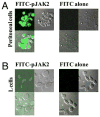Enhancement of antiviral immunity by small molecule antagonist of suppressor of cytokine signaling
- PMID: 20543109
- PMCID: PMC3031960
- DOI: 10.4049/jimmunol.0902895
Enhancement of antiviral immunity by small molecule antagonist of suppressor of cytokine signaling
Abstract
Suppressors of cytokine signaling (SOCSs) are negative regulators of both innate and adaptive immunity via inhibition of signaling by cytokines such as type I and type II IFNs. We have developed a small peptide antagonist of SOCS-1 that corresponds to the activation loop of JAK2. SOCS-1 inhibits both type I and type II IFN activities by binding to the kinase activation loop via the kinase inhibitory region of the SOCS. The antagonist, pJAK2(1001-1013), inhibited the replication of vaccinia virus and encephalomyocarditis virus in cell culture, suggesting that it possesses broad antiviral activity. In addition, pJAK2(1001-1013) protected mice against lethal vaccinia and encephalomyocarditis virus infection. pJAK2(1001-1013) increased the intracellular level of the constitutive IFN-beta, which may play a role in the antagonist antiviral effect at the cellular level. Ab neutralization suggests that constitutive IFN-beta may act intracellularly, consistent with recent findings on IFN-gamma intracellular signaling. pJAK2(1001-1013) also synergizes with IFNs as per IFN-gamma mimetic to exert a multiplicative antiviral effect at the level of transcription, the cell, and protection of mice against lethal viral infection. pJAK2(1001-1013) binds to the kinase inhibitory region of both SOCS-1 and SOCS-3 and blocks their inhibitory effects on the IFN-gamma activation site promoter. In addition to a direct antiviral effect and synergism with IFN, the SOCS antagonist also exhibits adjuvant effects on humoral and cellular immunity as well as an enhancement of polyinosinic-polycytidylic acid activation of TLR3. The SOCS antagonist thus presents a novel and effective approach to enhancement of host defense against viruses.
Conflict of interest statement
The authors have no financial conflicts of interest.
Figures









Similar articles
-
Both the suppressor of cytokine signaling 1 (SOCS-1) kinase inhibitory region and SOCS-1 mimetic bind to JAK2 autophosphorylation site: implications for the development of a SOCS-1 antagonist.J Immunol. 2007 Apr 15;178(8):5058-68. doi: 10.4049/jimmunol.178.8.5058. J Immunol. 2007. PMID: 17404288
-
SOCS-1 mimetics protect mice against lethal poxvirus infection: identification of a novel endogenous antiviral system.J Virol. 2009 Feb;83(3):1402-15. doi: 10.1128/JVI.01138-08. Epub 2008 Nov 19. J Virol. 2009. PMID: 19019946 Free PMC article.
-
HSV-1-induced SOCS-1 expression in keratinocytes: use of a SOCS-1 antagonist to block a novel mechanism of viral immune evasion.J Immunol. 2009 Jul 15;183(2):1253-62. doi: 10.4049/jimmunol.0900570. Epub 2009 Jun 19. J Immunol. 2009. PMID: 19542368 Free PMC article.
-
SOCS, Intrinsic Virulence Factors, and Treatment of COVID-19.Front Immunol. 2020 Oct 23;11:582102. doi: 10.3389/fimmu.2020.582102. eCollection 2020. Front Immunol. 2020. PMID: 33193390 Free PMC article. Review.
-
Disparate viral pandemics from COVID19 to monkeypox and beyond: a simple, effective and universal therapeutic approach hiding in plain sight.Front Immunol. 2023 Dec 1;14:1208828. doi: 10.3389/fimmu.2023.1208828. eCollection 2023. Front Immunol. 2023. PMID: 38106428 Free PMC article. Review.
Cited by
-
Short peptide type I interferon mimetics: therapeutics for experimental allergic encephalomyelitis, melanoma, and viral infections.J Interferon Cytokine Res. 2014 Oct;34(10):802-9. doi: 10.1089/jir.2014.0041. Epub 2014 May 8. J Interferon Cytokine Res. 2014. PMID: 24811478 Free PMC article.
-
A SOCS1/3 Antagonist Peptide Protects Mice Against Lethal Infection with Influenza A Virus.Front Immunol. 2015 Nov 11;6:574. doi: 10.3389/fimmu.2015.00574. eCollection 2015. Front Immunol. 2015. PMID: 26617608 Free PMC article.
-
A suppressor of cytokine signaling 1 antagonist enhances antigen-presenting capacity and tumor cell antigen-specific cytotoxic T lymphocyte responses by human monocyte-derived dendritic cells.Clin Vaccine Immunol. 2013 Sep;20(9):1449-56. doi: 10.1128/CVI.00130-13. Epub 2013 Jul 24. Clin Vaccine Immunol. 2013. PMID: 23885028 Free PMC article.
-
Transcriptomic analysis of the woodchuck model of chronic hepatitis B.Hepatology. 2012 Sep;56(3):820-30. doi: 10.1002/hep.25730. Epub 2012 Jul 12. Hepatology. 2012. PMID: 22431061 Free PMC article.
-
Zika Virus-Induction of the Suppressor of Cytokine Signaling 1/3 Contributes to the Modulation of Viral Replication.Pathogens. 2020 Feb 27;9(3):163. doi: 10.3390/pathogens9030163. Pathogens. 2020. PMID: 32120897 Free PMC article.
References
-
- Moss B. Poxviridae. In: Knipe DM, Howley PM, editors. Fields Virology. 3. Lippincott, Williams, and Wilkins; Philadelphia, PA: 2007. pp. 2905–2945.
-
- Smith GL, McFadden G. Smallpox: anything to declare? Nat Rev Immunol. 2002;2:521–527. - PubMed
-
- Moss B, Shisler JL. Immunology 101 at poxvirus U: immune evasion genes. Semin Immunol. 2001;13:59–66. - PubMed
-
- Alcamí A, Smith GL. The vaccinia virus soluble interferon-gamma receptor is a homodimer. J Gen Virol. 2002;83:545–549. - PubMed
Publication types
MeSH terms
Substances
Grants and funding
LinkOut - more resources
Full Text Sources
Other Literature Sources
Miscellaneous

